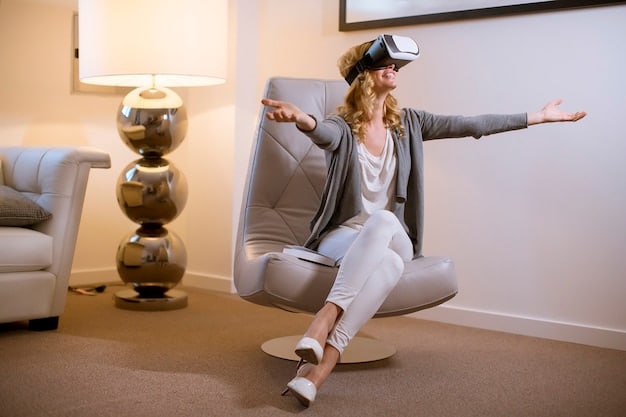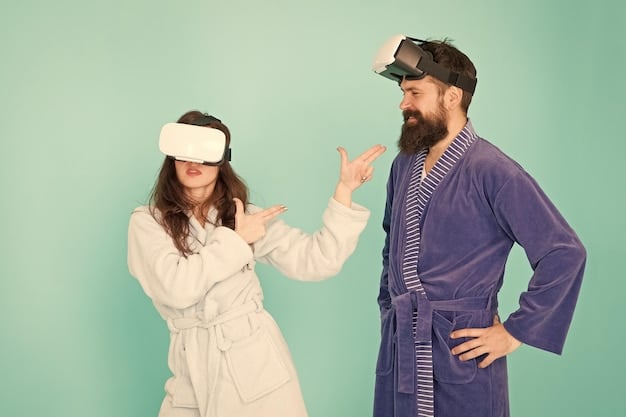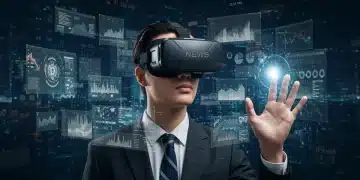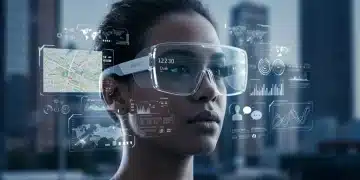Extended Reality (XR) Headsets: Are They Ready for Mainstream Adoption?

Extended Reality (XR) headsets are rapidly evolving, but their mainstream adoption hinges on factors like affordability, usability, content availability, and technological advancements that address current limitations.
Are Extended Reality (XR) Headsets: Are They Ready for Mainstream Adoption? The answer is complex, shaped by technological advancements, content availability, and consumer acceptance.
Understanding Extended Reality (XR) Headsets
Extended Reality (XR) encompasses a spectrum of immersive technologies, blending the physical and digital worlds. To understand if XR headsets are ready for mainstream adoption, it’s essential to define what XR is and the various types of headsets available.
What is Extended Reality (XR)?
XR is an umbrella term that includes virtual reality (VR), augmented reality (AR), and mixed reality (MR). VR creates fully immersive digital experiences, AR overlays digital information onto the real world, and MR blends both, allowing digital and real-world objects to interact.
Types of XR Headsets
XR headsets come in various forms, each designed for specific purposes. VR headsets like the Oculus Quest 2 (Meta Quest 2) or HTC Vive Focus 3 offer full immersion, while AR headsets such as the Microsoft HoloLens 2 provide a transparent display for overlaying digital content. Standalone headsets offer all-in-one functionality, while tethered headsets require connection to a computer or gaming console.

- Virtual Reality (VR) Headsets: Designed for immersive gaming, simulations, and training applications.
- Augmented Reality (AR) Headsets: Used for enterprise solutions, remote assistance, and heads-up displays.
- Mixed Reality (MR) Headsets: Combining VR and AR elements, offering interactive and collaborative experiences.
Understanding the different types of XR headsets helps to assess their potential for mainstream adoption. Each type caters to different user needs and applications, influencing their market penetration.
Current State of XR Technology
The current state of XR technology is marked by significant advancements and ongoing challenges. Evaluating the hardware capabilities, software ecosystems, and current market penetration is crucial for determining mainstream readiness.
Hardware Capabilities and Limitations
Modern XR headsets boast impressive displays, powerful processors, and advanced tracking capabilities. However, limitations such as battery life, weight, and field of view still need improvement. High-resolution displays and fast refresh rates enhance visual fidelity, but also strain processing power and battery life.
Software and Content Ecosystems
The availability of compelling content is a key driver for XR adoption. VR gaming has seen significant growth, but AR and MR applications are still developing. The software ecosystem needs more diverse and engaging experiences to attract a broader audience. Platforms like SteamVR and the Oculus Store offer a range of VR content, while AR development is focused on enterprise and niche applications.
- Display Technology: High resolution and refresh rates for improved visual clarity.
- Processing Power: Faster processors for seamless performance and complex simulations.
- Tracking and Input: Accurate tracking for realistic interaction and intuitive controls.
Despite these advancements, the high cost of XR headsets remains a barrier to entry for many consumers. Affordable options like the Meta Quest 2 have made VR more accessible, but AR and MR headsets remain expensive.
Factors Influencing Mainstream Adoption
Several factors play a critical role in determining whether XR headsets are ready for mainstream adoption. These include cost, usability, content availability, and technological advancements.

Cost and Affordability
The price point of XR headsets is a significant barrier for many consumers. Lowering the cost of entry-level devices and offering more affordable options can drive adoption. Subsidized hardware, financing options, and bundled content offers can make XR more accessible.
Usability and User Experience
XR headsets need to be easy to use and comfortable to wear. Bulky designs, complex setup processes, and motion sickness issues can deter potential users. Improving ergonomics, simplifying user interfaces, and addressing motion sickness are essential for enhancing the user experience.
The current state of XR technology is promising, but several challenges need to be addressed before mainstream adoption can occur. Overcoming these barriers will pave the way for widespread use in various applications.
Content Availability and Diversity
A diverse and engaging content library is crucial for attracting a broader audience. VR gaming has been a primary driver, but more immersive and interactive AR and MR experiences are needed. Educational applications, enterprise solutions, and social VR platforms can expand the appeal of XR.
Potential Applications Across Industries
XR technology has the potential to revolutionize various industries, from gaming and entertainment to healthcare and education. Exploring these potential applications can highlight the value proposition of XR headsets.
Gaming and Entertainment
VR gaming offers immersive and interactive experiences that traditional gaming cannot match. AR can enhance entertainment by overlaying digital content onto the real world, creating engaging and interactive narratives. Games like Beat Saber and Half-Life: Alyx have demonstrated the potential of VR gaming.
Healthcare and Training
XR can be used for medical training, surgical simulations, and remote patient care. AR can assist surgeons in performing complex procedures, while VR can provide immersive training environments for medical students. VR therapy has also shown promise in treating anxiety, phobias, and PTSD.
Education and Training
XR offers immersive learning experiences that enhance understanding and retention. VR can transport students to historical sites or simulate scientific experiments, while AR can provide interactive educational content. Training simulations in industries like aviation and manufacturing can improve safety and efficiency.
- VR Therapy: Treating mental health conditions through immersive simulations.
- AR-Assisted Surgery: Enhancing precision and accuracy in surgical procedures.
- VR Training Simulations: Providing realistic training environments for various industries.
The diverse applications of XR technology across different industries demonstrate its potential to transform how we work, learn, and interact with the world.
Challenges and Obstacles to Overcome
Despite the potential benefits, several challenges and obstacles need to be overcome for XR headsets to achieve mainstream adoption. These include technological limitations, content gaps, and user acceptance issues.
Technological Limitations
Battery life, weight, and field of view are ongoing challenges for XR headsets. Advancements in display technology, battery technology, and ergonomics are needed to improve the user experience. Higher resolution displays and wider fields of view can enhance immersion, but also strain processing power and battery life.
Content Gaps
The lack of diverse and engaging content is a significant barrier to XR adoption. More immersive and interactive AR and MR experiences are needed to attract a broader audience. Developing compelling applications in education, healthcare, and enterprise can expand the appeal of XR.
User Acceptance and Comfort
Motion sickness, discomfort, and social acceptance are issues that need to be addressed. Improving ergonomics, simplifying user interfaces, and promoting awareness of the benefits of XR can enhance user acceptance. Addressing concerns about privacy and data security is also essential.
Future Trends and Predictions for XR
The future of XR technology is promising, with several trends and predictions shaping its development. Advancements in hardware, software, and applications will drive mainstream adoption.
Advancements in Hardware
Future XR headsets will likely be lighter, more comfortable, and more powerful. Improved display technology, longer battery life, and enhanced tracking capabilities will enhance the user experience. Developments in neural interfaces and haptic feedback can also create more immersive interactions.
Overcoming these challenges is essential for unlocking the full potential of XR technology and paving the way for mainstream adoption. Innovation and collaboration are key to addressing these obstacles.
Software and Platform Development
More sophisticated software platforms and development tools will enable the creation of more immersive and interactive experiences. AI and machine learning will play a greater role in enhancing XR applications. Cloud-based XR platforms will enable seamless streaming and collaboration.
Integration with 5G and Cloud Computing
The integration of 5G and cloud computing will enable more powerful and seamless XR experiences. Low-latency connectivity and scalable computing resources will enhance the performance and accessibility of XR applications. Remote rendering and streaming will reduce the processing burden on XR headsets.
| Key Point | Brief Description |
|---|---|
| 🚀 Tech Advancements | Hardware improvements are crucial for better user experience. |
| 🎮 Content Is Key | Diverse content needed to attract broader audiences. |
| 💰 Cost Matters | Affordable headset options can drive adoption. |
| 🩺 Industry Use | XR offers solutions for healthcare, training, and more. |
Frequently Asked Questions (FAQ)
▼
VR replaces your real-world view with a digital environment. AR overlays digital elements onto the real world. MR blends real and virtual objects for interactive experiences.
▼
High cost, limited content, and usability issues are key challenges. Technological limitations and social acceptance also influence adoption rates significantly.
▼
XR is used for surgical training, remote patient care, and therapy. VR can simulate medical scenarios, AR assists surgeons during operations.
▼
Lighter, more powerful headsets, better display technology, and enhanced tracking are expected. Integration with 5G and AI will also enhance XR experiences.
▼
Conclusion
In conclusion, while Extended Reality (XR) Headsets: Are They Ready for Mainstream Adoption? significant advancements have been made, challenges remain in terms of cost, usability, and content. Overcoming these obstacles will pave the way for broader adoption across various industries, promising a future where immersive technology transforms how we live, work, and play.





